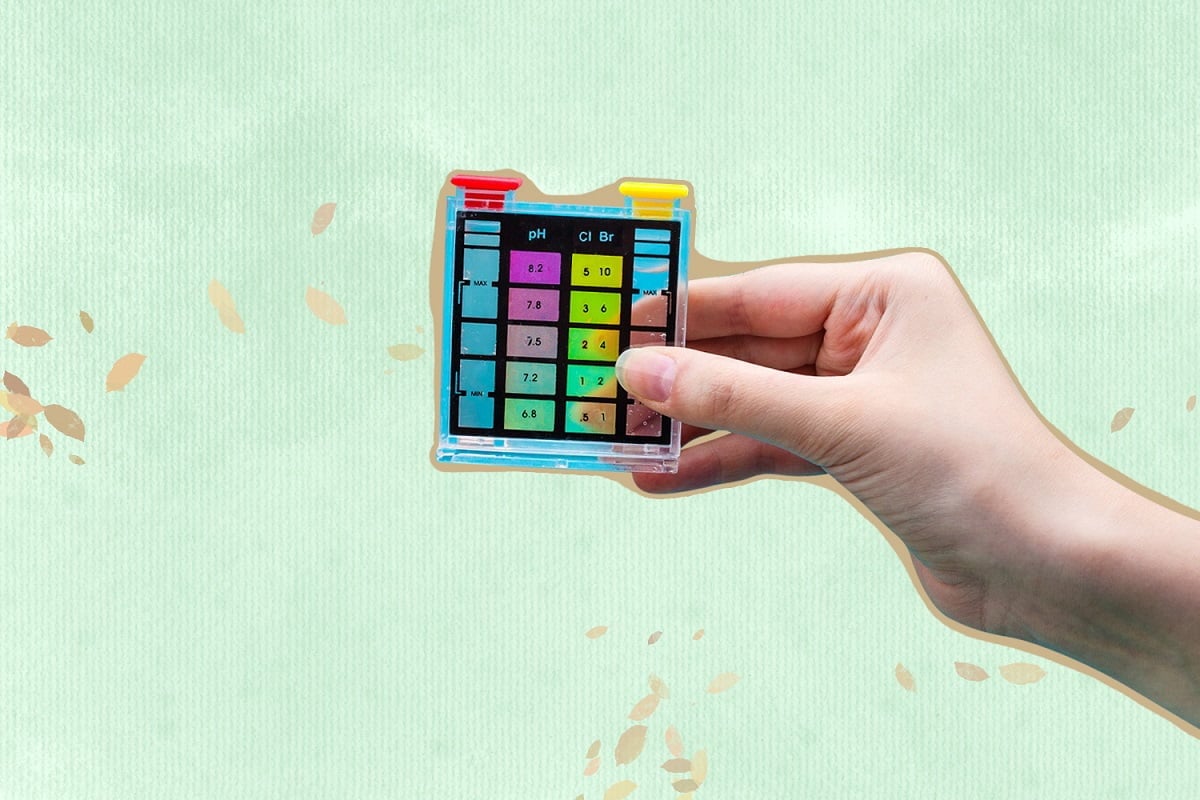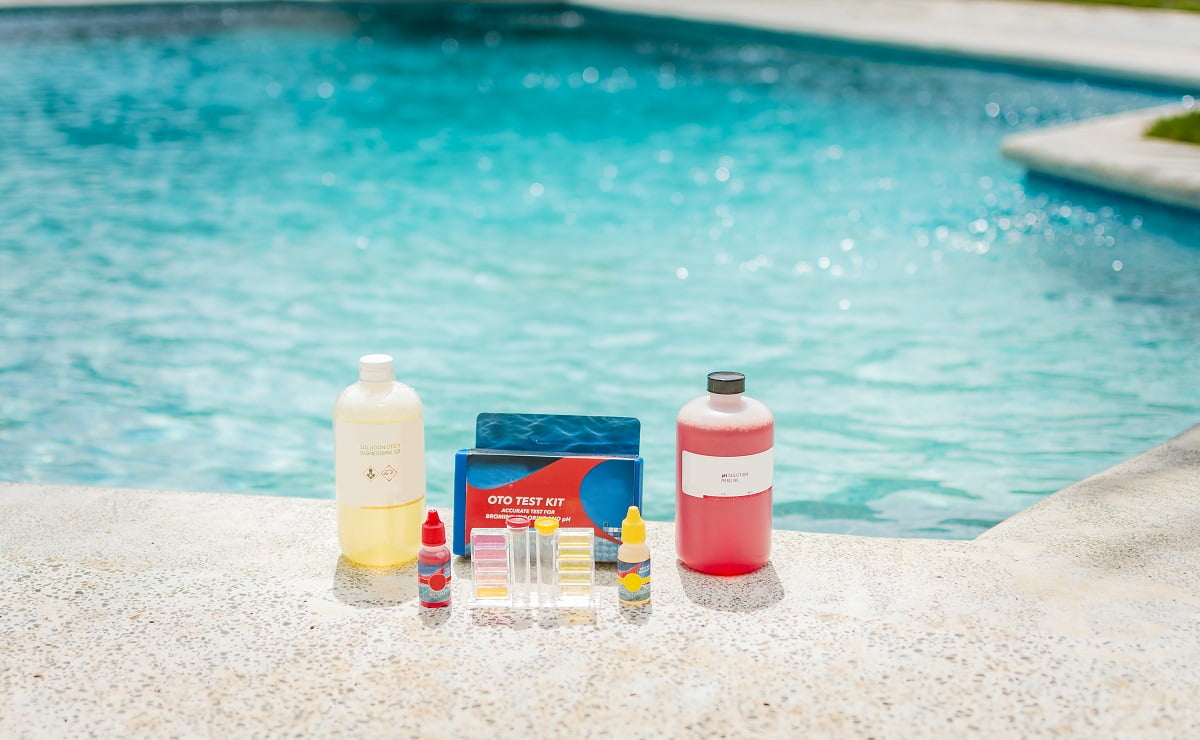In the absence of a testing kit, the amount of chlorine present in pool water can be tested using distilled water and red cabbage. Testing strips, liquid test kits, and digital testers are other reliable methods for testing chlorine levels in pool water.

Having the best pool test kits at your disposal allows pool owners to test chlorine levels of swimming pool water.
Besides, these kits are useful for testing total alkalinity, pool salt, calcium, bacteria, and other contaminants. But how would you test pool water when these kits aren’t available? – That’s what this guide is all about.
We’ll walk you through some DIY ways to test your pool water without a kit. Let’s dive in, then!
Why Should You Test Your Pool Water?

Testing the pool water regularly will help you maintain its water chemistry, but that isn’t the only reason you should conduct a pool test. By testing your pool water on a regular basis, you can prevent the growth of algae and bacteria in the water. And since our skin is highly sensitive, swimming in pools with low pH or high chlorine levels and bacteria can cause irritation.
Additionally, if the water contains a high amount of chlorine or is acidic, it can damage the pool walls and corrode its metal parts, like ladders and rails. The high acidity of water is especially problematic if you have a heated pool because it erodes the copper element of the heater very quickly.
How Frequently Should You Test Your Pool Water?
Several factors determine how frequently you should test your pool water, but ideally, the initiative should be undertaken at least once a week. But in seasons when the swimming pool is used more frequently, such as in summer, it’s advisable to test the pool water twice a week.
You must also consider testing your pool water after rain and heavy storms since such phenomena can alter its chemical balance. As a pool owner, you must test the water whenever you notice muddiness or a color change.
The frequency of pool water testing also depends upon the types of tests you conduct. For instance, pH and chlorine tests must be conducted twice or thrice a week, whereas testing alkalinity once a week is enough. Furthermore, cyanuric acid must be tested no more than once a month, and acidity testing should be done whenever you need to adjust pH levels.
Testing Your Pool Water Without A Kit
Want to test the chlorine levels of your pool water but unsure how to do without a kit? Well, don’t worry, for we have mentioned some of the most effective ways that you can adopt to test pool water in the absence of a testing kit.
1. Distilled Water And Cabbage Method
To test chlorine levels in pool water with this DIY method, you’ll have to have red cabbage and distilled water, which can easily be purchased from the market. You will also need a strainer, pot, clear container, and knife, all of which are household items.
The first thing to do is to cut the cabbage leaves into small pieces and pour the distilled water into a pot to boil. Once it starts boiling, immerse the cabbage in the water and let it boil for at least 30 minutes. Keep stirring the solution with a spoon or ladle every now and then; after 30 minutes, the crystal-clear water will turn purple.
Then, strain the purple water to remove the cabbage leaves from the solution and get some water from your pool in a container to conduct the test. Next, add just a few drops of purple water to the pool water container.
After a few minutes, you’ll notice the water changing its color depending on the pH level of the water, helping you determine the amount of liquid chlorine present in it. Higher amounts of chlorine can reduce pH levels and make the water acidic.
If the water becomes slightly red, it is acidic, but if it turns light green, it is alkaline. In case the water remains purple, it is neutral. If you have any doubts, use a pH test chart to understand what the color changes indicate.
DIY Tip
To make things easier, you can make your own DIY pH indicator using filter paper as a testing strip. The process will involve soaking the paper in the cabbage water and letting it dry. Once it dries, put a small amount of water onto the strip, which will change its color depending on the pH levels of your pool water.
2. pH Testing Strips
Strip testing is among the easiest and most cost-effective methods of testing your pool water and provides quick and accurate results. Basic test strips test pH, chlorine, and alkaline levels, but others can test copper, iron, salt, and more. Some testing strips can test as many as seven chemicals.
To test the chlorine level, take a sample of the pool water and simply dip the testing strip into it. The test strip will change color depending on the pH level, and the color can be compared to the indicators on the pH chart. These indicators are also mentioned on the back of the bottle of the testing strip.
For those wondering, are pool testing strips accurate, let us tell you that they are highly reliable and can eliminate human errors effectively. Hence, you can use them to test chlorine in the absence of a pool testing kit.
3. Liquid Test Kits
Another method of testing pool water is to use a liquid test kit, which offers even more accurate results than testing strips. To use such kits, you need to add certain reagents to the sample of pool water, which may include phenol red and orthotolidine (OTO).
For testing the pool water using a liquid test kit, collect samples of the water in vials included in the kit, ensuring you fill them up to the fill line. Once the vials are filled, add a few drops of the required reagent to the water sample.
Make sure to check the instructions that come with the kit to know how many drops need to be added for testing different chemicals. After the reagents have been added, shake the vials to mix them with water, and then compare the color of the resulting mixture with the provided color chart. You may repeat the process if need be and use different reagents for testing various chemicals.
And if you’re wondering, “do pool test kits expire,” let us tell you that most come with a shelf life of more than two years.
4. Digital Testers
Pool owners can use a digital water tester to test pool water and check the free chlorine or pH levels present. While such testers tend to be more expensive than other types, they offer certain advantages over other testing techniques.
Digital testers offer an accurate reading of the chlorine levels, so you won’t have to depend on the pH scale to determine the pH levels. One advantage of digital testers is that you won’t have to refill them, which adds to their user-friendliness. Though expensive, they are reusable, making them a cost-effective option compared to liquid test kits and testing strips.
There are different types of digital testers– some need to be dipped into the water sample, while others come with testing strips. In the latter case, a testing strip is dipped into the pool water and later inserted into the tester to get a reading of the chlorine present in your pool.

How To Test Chlorine In Pool Without Kit Final Thoughts
Whether you have stone, PVC, or concrete pools, regularly testing pool water is crucial to make sure it is safe for swimming. In the absence of a pool test kit, you can try using these methods for testing chlorine and pH levels.
These simple DIY methods will help you maintain proper pool chemistry, prevent bacteria and other microorganisms from thriving, and keep it safe from corrosion. And if testing pool water every week or so seems like a challenge, it’s best to hire professional pool maintenance service providers for the same.
With that, it’s time to call curtains for the day. No matter which testing method you opt for, you can rest assured that the results will be accurate.
See you later!
